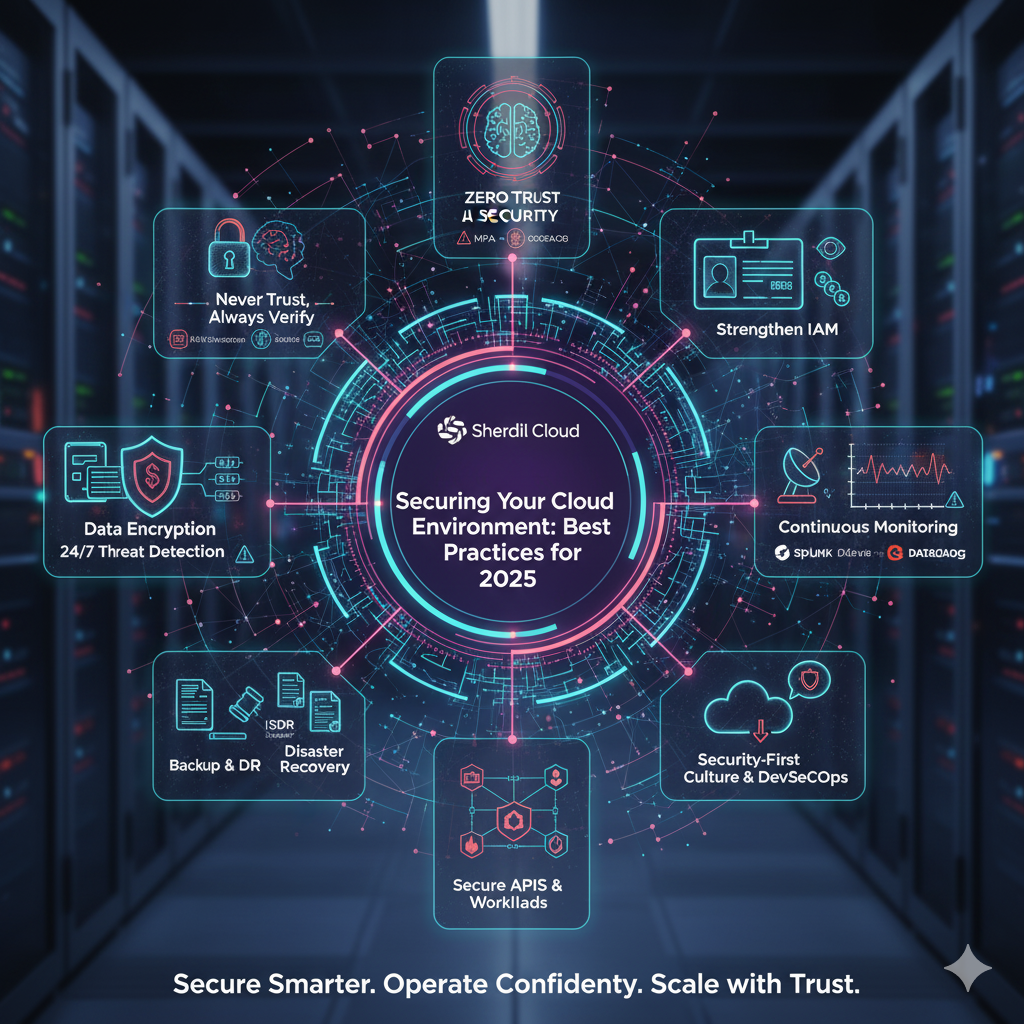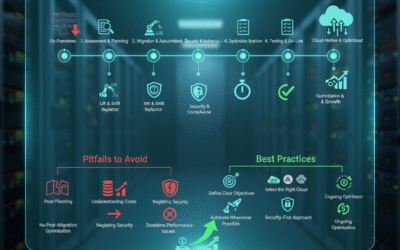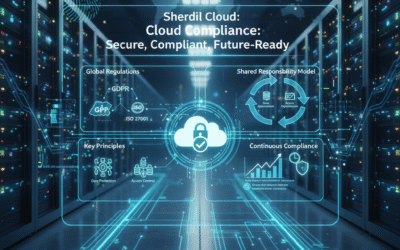In today’s developing digital environment, cloud computing is the pillar of contemporary business activities. From startups to multinational companies, organizations use cloud platforms to hold data, host applications, and fuel innovation. But as the adoption of cloud computing increases, so do the issues surrounding security, compliance, and data protection.
At Sherdil Cloud, we’re of the opinion that a solid cloud strategy can only be completed with a solid security basis. As we head into 2025, the threat environment is more sophisticated than ever, with more sophisticated cyberattacks, rising AI-powered breaches, and more regulatory scrutiny. Organizations need to switch to proactive, adaptive, and intelligence-driven cloud security solutions in order to protect their business.
This article discusses the best practices for defending your cloud environment in 2025, assisting you in building resilience, achieving compliance, and sustaining trust throughout your digital ecosystem.
1. Adopt a Zero Trust Security Model
Those days are gone when perimeter security was sufficient. In 2025, Zero Trust Architecture (ZTA) is the norm for safeguarding cloud infrastructure. The motto is easy: never trust, always verify.
With Zero Trust, all users, devices, and applications need to authenticate on an ongoing basis even within the organization’s network. Access is determined on the basis of identity, device health, location, and behavioral analytics.
At Sherdil Cloud, we assist companies in deploying Zero Trust architectures through:
-Enforcing multi-factor authentication (MFA) on all accounts.
-Network segmentation to segregate workloads and contain breach impact.
-User behavior monitoring using AI-powered anomaly detection.
-Implementing the principle of least privilege (PoLP) to grant users access only to what they require.
-Adopting Zero Trust can help organizations greatly minimize the risk of insider threats as well as unauthorized access.
2. Strengthen Identity and Access Management (IAM)
Inadequate or improperly configured access controls still rank among the leading cloud breach causes. A solid Identity and Access Management (IAM) policy guarantees that the correct personnel accesses the proper resources, nothing more, nothing less. Practices of excellence are:
-Use role-based access control (RBAC) to simplify permissions.
-Audit user accounts on a regular basis and delete inactive or orphaned identities.
-Apply just-in-time (JIT) access to provide time-limited approvals for high-impact procedures.
-Integrate IAM with your SSO (Single Sign-On) and MFA systems for uniform enforcement.
At Sherdil Cloud, we implement sophisticated IAM frameworks that combine automation, analytics, and policy-based access to cut down on human error and enhance compliance.
3. Data Encryption: Your First Line of Defense
Security starts with encryption. Whether data is being stored, transmitted, or used, encryption keeps it inaccessible to the wrong hands. In 2025, quantum-resistant cryptography algorithms and homomorphic encryption are gaining prominence to keep pace with evolving threats. Yet, even conventional encryption techniques, when properly administered, provide excellent protection.
Sherdil Cloud advises:
-Encrypting data end-to-end with AES-256 or higher standards.
-Securely managing encryption keys using cloud-native KMS (Key Management Services).
-Encrypting all communication channels, but particularly APIs and internal service calls.
-Rotating encryption keys periodically to reduce exposure risks.
-Comprehensive encryption policies ensure that even in the event of a breach, your data is safe.
4. Continuous Monitoring and Threat Detection
Static defenses are now obsolete in the age of real-time attacks. Cloud infrastructures need real-time visibility and smart threat detection to be able to keep pace with emerging threats. Sherdil Cloud combines products such as AWS GuardDuty, Azure Defender, and Google Chronicle with SIEM products like Splunk and Datadog to enable 24/7 monitoring.
Chief strategies are:
-Configuring automated alarm for suspicious login activity or traffic spikes.
-Employing AI and machine learning to detect suspicious behaviors before they escalate.
-Correlating across multi-cloud environments for a single pane of glass threat visibility.
-Regularly performing vulnerability scans and penetration tests to spot vulnerabilities.
This proactive monitoring enables teams to detect, respond, and remediate threats in real-time, lowering the mean time to detect (MTTD) and resolve (MTTR) incidents.
5. Compliance and Regulatory Alignment
Compliance in 2025 is no longer a checkbox, it’s a competitive advantage. With guidelines such as GDPR, ISO 27001, HIPAA, and SOC 2, companies need to prove that they deal with customer data in a responsible manner. Sherdil Cloud helps clients attain and sustain compliance through:
- Compliance audits that review configurations and controls automatically.
- Data residency and sovereignty management to adhere to local laws.
- Documentation and reporting to be audit-ready.
- Security posture assessments aligned with global standards.
By conforming to compliance frameworks, companies do not only escape regulatory sanctions but also create confidence amongst customers and partners.
6. Secure Your APIs and Workloads
APIs drive cloud-native apps but can also serve as points of entry for attackers if not secured. To protect workloads and integrations:
- Enforce API authentication and rate limiting to help prevent abuse.
- Test APIs for vulnerabilities routinely using automated security scanning tools.
- Use container security and runtime protection for Kubernetes environments.
- Use network policies and firewalls to govern east-west traffic between microservices.
At Sherdil Cloud, our specialists are experts at protecting APIs, workloads, and containers, keeping your app infrastructure safe and tamper-proof.
7. Backup, Disaster Recovery, and Business Continuity
No security plan is finished without a disaster recovery (DR) strategy. Even well-secure systems can have downtime caused by cyberattacks, human mistakes, or natural disasters.
Best practices are:
-Implementing automated backups in multiple regions.
-Applying immutable storage to prevent ransomware from modifying backups.
-Testing recovery plans on a regular basis for minimal downtime.
-Applying multi-region failover to mission-critical workloads.
Sherdil Cloud enables companies to build robust, fail-safe cloud infrastructures that maintain operations even in the face of unexpected disruption.
8. Foster a Security-First Culture
Technology cannot protect your cloud alone, people are essential. Human mistake is still one of the leading root causes of breaches, so security awareness and training is crucial. We at Sherdil Cloud recommend that organizations should:
- Provide frequent employee training workshops on credential hygiene and phishing.
- Develop a security incident response plan (SIRP) with well-defined escalation channels.
- Implement collaboration between DevOps and Security teams (DevSecOps) to enable risk identification early in the CI/CD pipeline.
A shared responsibility culture guarantees that all members of a team play their role in guarding the organization’s assets.
Conclusion: The Future of Cloud Security
As organizations adopt digital transformation, protecting cloud environments in 2025 needs more than just conventional defense measures. It needs to be constantly adapting, automated, and security-first.
At Sherdil Cloud, we enable organisations to do so with confidence. From cloud audits and Zero Trust architectures to automation, compliance, and 24/7 monitoring our end-to-end security services ensure your digital foundation remains strong, compliant, and future-proof.
The future of cloud security is not only about protecting your systems, it’s about empowered innovation without compromise. Let’s make 2025 the year your cloud is not only scalable, but securely so.



